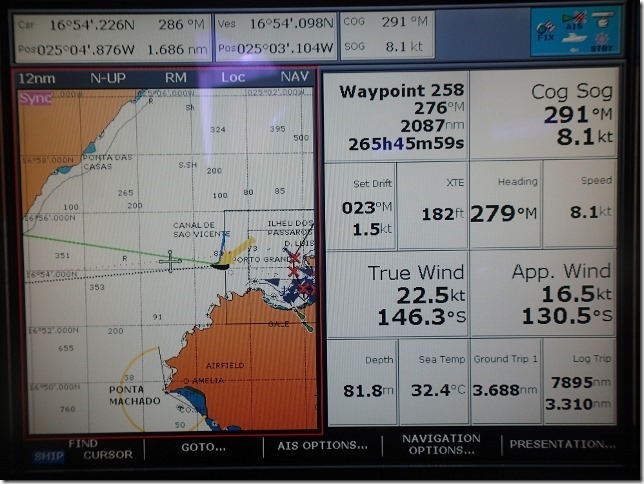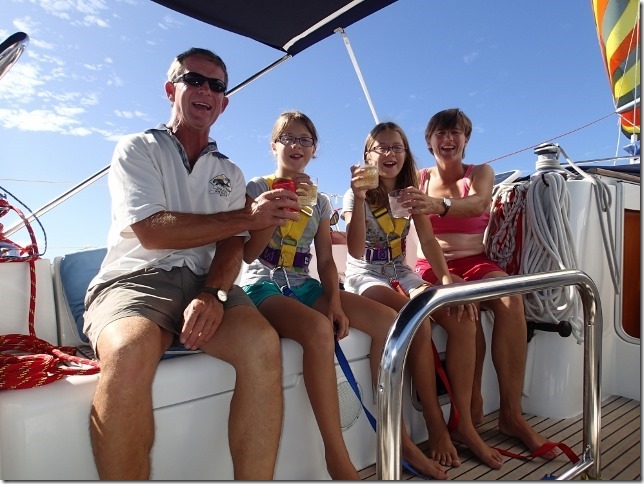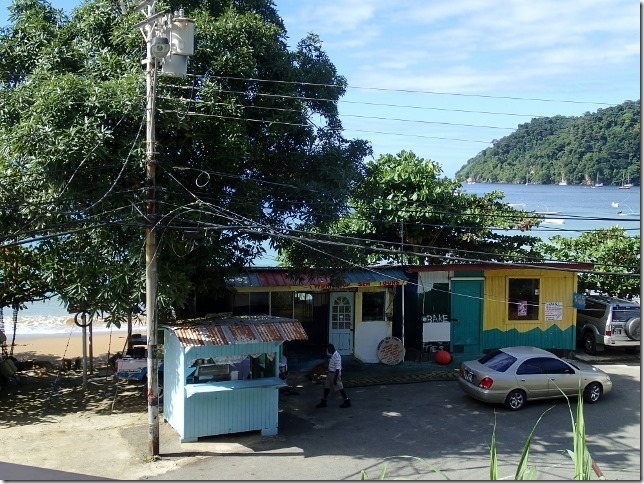Atlantic Crossing and Tobago

Silhouette
Pieter, Pauline, Robyn and Kerry Lindeque
Fri 6 Dec 2013 11:08
|
11:19.7N 60:33.1W
Whoosh and we are on the other side of the Atlantic. Well, it did take 12
days. We sailed the 2100 nautical miles at an average of 7.4 knots (nautical
miles per hour). We had 2 days of light winds where we motored at night and had
the spinnaker up for 1 of the days. The rest of the time we had good solid winds
and the odd rain squall in between. The rain squalls always come at night and
generally increase the wind, but sometimes also change direction of the wind.
This can be quite a nuisance or scary if it is a BIG one.
 The chart plotter showing our miles to go and estimated time
(note the 8.1 knots we were doing at the time we took the picture.) The chart plotter showing our miles to go and estimated time
(note the 8.1 knots we were doing at the time we took the picture.)Before departing, we stocked up on fresh meat and vegetables in Mindelo.
The fresh produce market was very helpful here. The bananas comes by truck
straight from the farm and none of the fruit and veg have been in the fridge.
The fresh food lasted very well – we had meat and fish for 7 days and arrived in
Tobago with the odd orange, apple and banana left over. We supplemented
our food with tins and prepacked meals, but we were able to keep that to a
minimum. Eggs and ham make a wonderful omelette and the girls baked top quality
bread rolls using premix bread mixture (getting a nice warm place for the yeast
to rise is of course very easily done).
Other than preparing food, we read a lot, the girls gave schooling a good
solid go (doing 3 lessons a day) and we all made sure that the boat was clean
and any wear and tear was kept under check. When you sail constantly for such a
long time there is invariably wear on ropes, sails or canvas covers. The genoa
sheets that we thread through a pole (the pole keeps the sail stretched out to
the one side) was chafed badly and here in Tobago we cut off the damaged ends
and smoothened the pole eye. During the night Pieter and I stood 3 hour watches
which can be a really peaceful time alone if you are not too tired. We did catch
up on a hour sleep during the day to keep spirits up. The one problem during the
day was the heat, especially on the days with light winds. The boat inside can
get very hot (30 deg C) and of course the high humidity in the tropics does not
help.
 Celebrating our half way point. Taken on one of the days with light winds
(spinnaker just visible on the right)
Celebrating our half way point. Taken on one of the days with light winds
(spinnaker just visible on the right)Our landfall in the Caribbean was in Charlotteville, Tobago. This is a
small village in the northwest of the island. Although they would like more
foreigners, the town is not on the main tourist track. This suited us well and
you experience how people in Tobago live. Food is bought at small shacks or mini
markets. They seemed to all sell similar goods with some specialising in fruit
and veg and others more in dry goods. There are also a lot of little cafes and
food shacks once again selling similar produce. Everything is available when you
slowly find your way around and get to know the who-does-what of the town. Fresh
fish is obviously easy to get. Mostly we bought fish or lobster from the
fishermen as they returned to port.
 The tuna Pieter did not catch. Bought for $80TT (about £8) from a
fisherman.
The tuna Pieter did not catch. Bought for $80TT (about £8) from a
fisherman. Charlotteville, Tobago
Charlotteville, TobagoNext stop is Grenada. Au
revoir! |